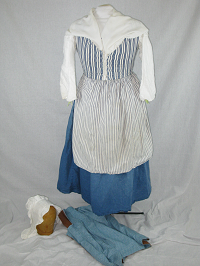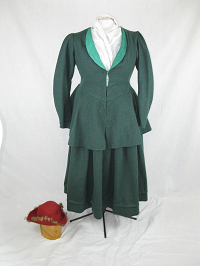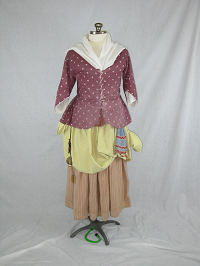
- Details
- Category: 18th Century
- Hits: 2799
1795-1800
The French Revolution brought about a dramatic change in clothing. The interest in classical Greece meant a new freedom for the body which had long been confined in metal, bone, and cloth. At first ladies wore only chemises, but they found it took a perfect figure to display them properly, so they soon added tunics and open gowns, like this yellow silk chemise beneath a pale wool open gown. The frontpiece, called a vest, is closed with straight pins. It was still not fashionable for women to wear buttons. The shoulder seam set far to the back, runs down into the armhole, where it is met by the back seams. The skirt and bodice are cut in one piece with the back seams falling into box pleats to allow the needed fullness at the hipline. A small pad keeps the gown in a straight line, shoulders to hips. Red cording accents the seams and front opening.
The practice of cutting the hair of the nobles before sending them to the guillotine inspired short hair styles that were covered by a fanciful turban. Gloves covered the exposed arms and hands. Short gloves were worn with long sleeves and long with short sleeves. A reticule was carried for necessities, such as a nose cloth, or perhaps a few pennies for the beggars. Shoes were of soft leather and had no heel; sometimes, like a sandle, they included ties up the leg.
Click photo for detailed views.
- Details
- Category: 18th Century
- Hits: 2646
1770s
Women of better means (gentry) also needed utilitarian clothing, and theirs displayed their wealth and class.
A hand-embroidered fitted linen jacket with 3/4-length sleeves is laced up the front with a silk ribbon. The white pulled-thread linen kerchief is tucked into the corset above a pinafore style whine linen apron. The apron's bib is pinned to the jacket with straight pins and tied around the waist.
The ankle-length petticoat is of red linen (finished width is 90-108 inches).
When necessary to leave home during cool or inclement weather, a red wool cape and hat provided stylish protection from the elements (see detailed views). The cape has an attached shawl collar that could be pulled up over the head as a hood. The hat is felted wool and was worn over the linen cap and attached with a hat pin.
Click photo for detailed views.
- Details
- Category: 18th Century
- Hits: 2735
1770s
The brown linen bed gown (see detailed views) has 3/4 sleeves fastened with straight pins and was intended to be worn at home.
The white linen kerchief is tucked into the corset. The apron is of blue and white striped linen; the type of material is also known as "ticking." A petticoat, also of blue linen (finished width 90-108 inches) is tied at the waist.
Like the apron, the split-bottomed bodice ("jumps") is also of blue and white striped linen (ticking). The bodice is boned and laces up the front.
The cap is linen, with ruffles, lappets, and ties.
Click photo for detailed views.
- Details
- Category: 18th Century
- Hits: 2728
1770s
A fitted jacket of cotton resist print, is laced up the front, has a scoop neck line, fitted sleeves and flairs at the waist to accommodate the hips and petticoats. The top petticoat is looped through the pocket slits to give the wider silhouette that was in fashion. Both petticoats are linen. A kerchief of white linen fill the neck line.
Beneath the jacket is a corset. A woman needed help to spiral lace the corset in the back. Tied around the waist is a woven tape that holds a chatelaine of needlepoint consisting of a pin ball, scissor case, and needle case. On the other side is a knit purse of blue, red, and white wool. Purses were usually carried by men as they had control of the "purse strings." A widow might carry a purse such as this. The shift has a gathered ruffle around the neck, and the sleeves end below the elbow. The shifts end about mid-calf.
Click photo for detailed views.
Page 1 of 4





